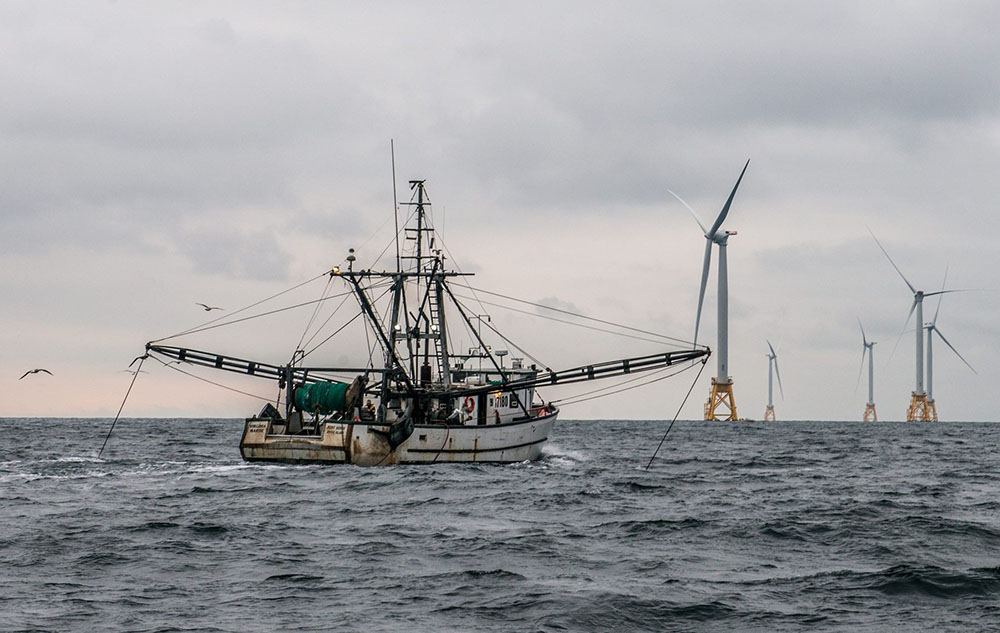July 2nd, 2020, by Annie Hawkins, NationalFisherman.com

By now, you have probably seen quite a bit about offshore wind energy development planned for multiple regions of the United States. Fishermen and related businesses understandably run the gamut from bewildered (“That would never happen where I fish”), to overwhelmed (“There’s too much else going on to pay attention”), to laser-focused (“Leases are on my fishing grounds”). Here are seven key reasons you should get involved now.
1. Wind is big
Just a few years ago, pilot or demonstration projects were the name of the game in U.S. offshore wind energy, but times have changed. Qualified companies are large and almost exclusively foreign-owned. Many or most are linked to governments and national oil and gas companies. They work closely with highly active trade associations, embassies, and investment firms.
The projects themselves are no less extraordinary. Current generation offshore wind turbines are three times the height of the Statute of Liberty, and the blades are among the largest composite human-made structures in existence. In the North Sea, Denmark even plans to build two artificial islands to house the large amount of offshore wind infrastructure there and export the power.
2. Conflicts are complex
There are so many aspects of interactions between offshore wind and fisheries that will be better understood the more the fishing industry brings its knowledge to the table. Offshore wind projects are not simply a series of “sticks in the water.”
In deeper waters of the Pacific, Hawaii and Gulf of Maine, floating platforms will be connected through a series of suspended cables. Inter-array cables run between turbines, and scour protection and mattressing extend far beyond the bases. The southern New England lease area alone is 1,400 square miles in area and transit distances around installations could be significant if adequate safety corridors are not required.
When viewed in conjunction with strict fisheries management measures, everything from interactions with protected resources to changes in port traffic and access will affect fisheries in ways that those outside the industry aren’t well-suited to understand without your involvement.
3. Early projects will set precedent
Just because the current projects are not located in your area doesn’t mean they won’t affect you. A relatively small group of developers own the leases, and the federal permitting process is being tested and tweaked in real time.
Even states are following closely in the footsteps of others, as was recently seen when Massachusetts largely followed a Rhode Island-developed process for compensatory mitigation for the Vineyard Wind project. The developer stated its intent for that process to set precedent for every project in every state. What’s more, practices for fisheries mitigation and conflict reduction are often being imported wholesale from Europe, and we’re seeing that trend in everything from the regulatory process to Coast Guard recommendations to the army of wind consultants developing “stakeholder” outreach plans.
While that can be positive where early lessons have been learned, it can also interfere with a full ability to address location-specific issues. The key point: for better or worse, we’re not starting from ground zero.
4. The process is nothing like fisheries management
Those familiar with the regional fishery management councils are used to transparent, inclusive decision making: whether you love or hate the outcome, you know where to go to be heard. Regardless of BOEM’s ultimate jurisdiction, in practice offshore wind planning is highly decentralized among federal agencies, and most design decisions are driven through state processes that also include multiple agencies and private sector groups.
A lot happens behind closed doors before any public announcements, particularly when it comes to the studies that determine siting locations. Public comment periods are very specific to given project decisions and phases, but there has been no early, comprehensive review of fisheries impacts.
5. Projects aren’t necessarily isolated
Project siting isn’t limited to areas with large coastal electricity markets and adequate shoreside transmission capacity. It also is, or will be, used to power remote industrial uses too — even oil and gas platforms! Entire conferences in Europe have been convened for years around topics like co-location of other activities in offshore wind arrays and the role of oil and gas in offshore renewables.
There is also evidence that a surge in renewables could require expansions in seabed mining for battery and technology components and offshore gravel extraction for materials. Regional planning approaches have linked these uses and the broader offshore wind community with MPA designations and large-scale ocean exploration and research efforts. The fishing industry is historically not great at tracking and engaging in these efforts.
6. Limited research exists on effects to fish
Although offshore wind has been in Europe for over a decade, there are very few peer-reviewed studies on its impacts to fisheries and fish stocks (a 2019 NMFS meta-analysis showed only 11 in total). Much of the known research is generated by wind companies and consultants, and the data they collect is often considered proprietary.
Click here to continue reading about fisheries and offshore wind
